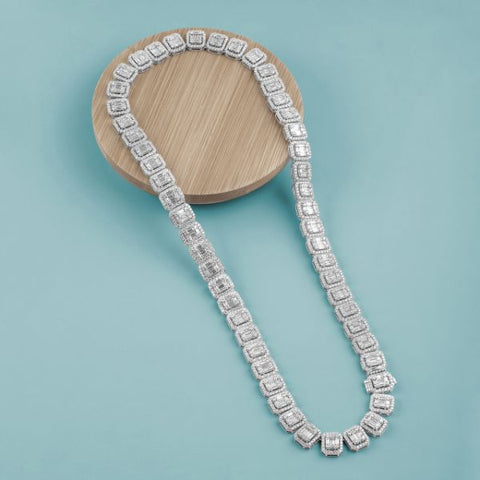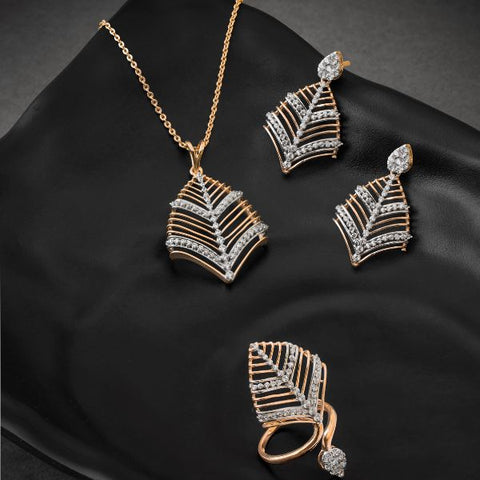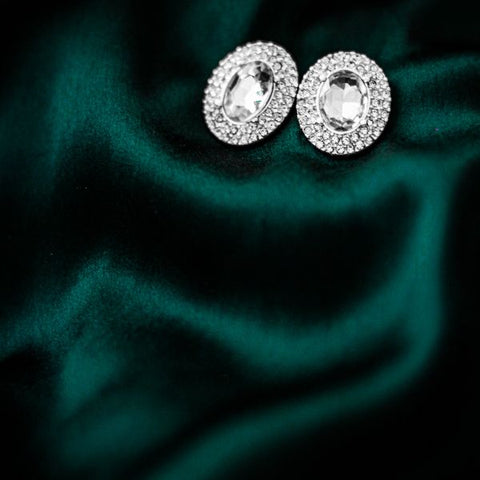
The Ultimate Guide to Choosing the Perfect Diamonds Jewelry
Diamonds have captured hearts for generations, representing love, dedication, and eternal brightness. Whether you're looking for the ideal engagement ring, a stunning statement piece, or a timeless present, selecting diamond jewelry may be an exciting yet scary experience. Don't worry, since this comprehensive guide will give you the information and confidence you need to traverse the world of diamonds and choose the item that speaks to you.
Diamonds are more than just a sign of grandeur and elegance; they also have sentimental worth as immortal heirlooms. Whether you're looking for an engagement ring, a gift for a loved one, or a personal pleasure, choosing the right diamond jewelry takes careful deliberation. In this comprehensive guide, we will look at the essential variables to consider when selecting diamond jewelry, allowing you to make an informed and confident purchase.
What is a Diamond?

Carbon atoms bonded securely over a billion years ago, deep beneath the Earth's surface, creating a diamond, the world's hardest natural stone.
Diamonds, which had been hidden for millions of years, only made it to the Earth's surface after volcanic activity brought them up in lava. The first diamonds were discovered in India during the fourth century BC. Diamonds are still one of the most beautiful and sought-after objects on the planet, as they have been for generations.
Types of Diamonds
Natural Diamonds
Natural diamonds originate deep below the Earth under severe temperatures and pressures. They are almost 99.95% carbon, with the remaining 0.05% reflecting trace atoms that are not fundamental to their chemistry, making diamonds the only gemstone made entirely of one element. They are the hardest naturally occurring material on Earth and one of the most desirable.
Lab Grown Diamonds
Laboratory diamonds have the same visual, chemical, and physical properties as natural diamonds. In other words, they look, feel, and are the same. Their sole difference is that natural diamonds originate within the earth, whereas lab diamonds are created by professionals using specialized equipment. Another distinction is in price; because lab-grown diamonds are less rare than natural diamonds, they are frequently less expensive.
4 C's of Diamonds
Diamonds are rigorously examined using four critical criteria known as the "4Cs": cut, color, clarity, and carat weight. Understanding these variables will help you make informed judgments and find a diamond that fits your budget and tastes.
- Cut: The most crucial aspect, the cut determines a diamond's brilliance, fire (play of colors), and scintillation (sparkle). A well-cut diamond reflects light flawlessly, resulting in a breathtaking display of sparkle. Round brilliant cuts are popular, but other fancy shapes like emerald or princess cuts offer unique aesthetics.
- Color: While most associate diamonds with colorless perfection, they naturally occur in a spectrum of hues. The Gemological Institute of America (GIA) grades diamond color on a scale from D (colorless) to Z (light yellow or brown). D-color diamonds are the most valuable, but slight variations in color may not be noticeable to the naked eye and can offer better value.
- Clarity: Refers to the presence of internal flaws (inclusions) and external blemishes on the diamond's surface. These imperfections can affect brilliance and value. Flawless diamonds are incredibly rare and expensive, but clarity grades like VS1 or VS2 often offer excellent beauty without compromising brilliance and remain a popular choice.
- Carat weight: Often confused with size, carat weight simply measures the diamond's weight. While larger diamonds generally command higher prices, remember that cut plays a significant role in perceived size. A well-cut diamond with a slightly lower carat weight can appear larger and more brilliant than a poorly cut diamond with a higher carat weight.
Diamond Certification
Many diamonds, including all of Shemesh Diamonds' diamonds, are certified by independent institutes such as the Gemological Institute of America (GIA), the International Gemological Institute (IGI), HRD Antwerp, and the Gem Certification & Assurance Lab. Trained specialists utilize specialized equipment to grade diamonds based on their cut, color, clarity, and carat. They may also create a schematic of its clear properties and a graphic depiction of its proportions. Certifications may also include notes about symmetry, polish, fluorescence, form, and measurements.
Certifications are important since they detail not only the qualitative attributes of the stone, but also its legitimacy. During the certification process, most diamonds are laser etched with a unique number that corresponds to the number on the certification, allowing you to visually prove that the diamond you have is the same one that was certified. We provide digital delivery to customers with their purchase. Providing digital certifications instead of paper certifications reduces our paper use, packing size, and shipping emissions, hence lowering our carbon footprint.
What Diamond Certifications Should You Look For?

Diamond certificates assure that you receive the color, cut, clarity, and carat size that you paid for. If you ever decide to sell the diamond, your certification will serve as proof of its genuineness.
While the Gemological Institute of America (GIA) is the primary authority on diamond certification, other recognized agencies such as the International Gemological Institute (IGI) and SGL Labs are also well-known internationally. All Diamondère diamonds are certified by reputable organizations such as GIA, IGI, and SGL.
Beyond the 4Cs: Additional Considerations
-
Setting: The metal surrounding the diamond plays a crucial role in its overall style and durability. Popular options include platinum, gold (white, yellow, or rose), and silver. Consider the color and weight of the metal in relation to the diamond and your desired look.
-
Certification: Reputable jewelers provide certificates from independent gemological laboratories like the GIA or American Gem Society (AGS). These certificates confirm the diamond's 4Cs and offer peace of mind regarding authenticity and value.
- Ethical Sourcing: With growing awareness, many individuals prioritize ethically sourced diamonds. Look for jewelers who adhere to ethical sourcing practices, ensuring your diamond journey reflects responsible choices.
Embrace Your Personal Style

Ultimately, the perfect diamond piece is the one that resonates with you. Consider the occasion, your personal style, and your comfort level when making your choice. Don't be afraid to experiment with different designs and styles to find a piece that complements your unique personality.
Choosing the Right Setting:
The setting of a diamond jewelry piece can greatly impact its appearance and wearability. Consider the following popular settings:
- Solitaire: A classic and timeless choice, solitaire settings feature a single diamond set on a simple band, allowing the diamond to take center stage.
- Halo: Halo settings surround the center diamond with a ring of smaller diamonds or gemstones, adding sparkle and brilliance to the overall design.
- Three-Stone: Three-stone settings symbolize the past, present, and future of a relationship, with each diamond representing a different moment in time.
- Pave: Pave settings feature small diamonds set closely together, creating a surface that appears to be paved with diamonds.
Choosing the Metal:
The metal used in diamond jewelry can enhance its beauty and complement the overall design. Common choices include:
- Platinum: Known for its durability and purity, platinum is a popular choice for diamond engagement rings and wedding bands.
- White Gold: White gold offers a similar look to platinum at a more affordable price point, making it a versatile option for diamond jewelry.
- Yellow Gold: Yellow gold exudes warmth and richness, adding a classic and traditional touch to diamond jewelry pieces.
- Rose Gold: Rose gold, with its romantic pink hue, adds a modern and feminine flair to diamond jewelry designs.
Choosing the perfect diamond jewelry involves a combination of personal preference, budget considerations, and knowledge of diamond quality factors. By understanding the 4Cs, selecting the right setting and metal, and insisting on certifications, you can confidently choose diamond jewelry pieces that reflect your style, personality, and values. With careful consideration and attention to detail, the perfect diamond jewelry piece will become a cherished symbol of love, beauty, and lasting memories.
Shopping Jewelry by Diamond Cut

Diamonds are a timeless emblem of beauty and elegance, and their cut plays an important part in boosting their radiance and appeal. Understanding the various diamond cuts is vital whether searching for a Diamond engagement ring, a necklace, or a pair of Diamond earrings. In this article, we will look at the most popular diamond cuts and how they affect the overall appearance of your jewelry.
Rounds Cut Diamonds Jewelry
Round cut diamonds are the most traditional and adaptable option for jewelry. Round-cut diamond Jewelry, with its bright sparkle and timeless appeal, makes ideal engagement rings, stud earrings, and solitaire pendants. Their symmetrical appearance and superb light output make them popular among people seeking elegance and sophistication.
Princess Cut Diamonds Jewelry
Square cut diamonds, also known as princess cut diamonds jewelry, are square or rectangular in shape and have pointed corners. Princess cut diamonds are a sophisticated and stylish alternative to typical round shapes. They are frequently used in engagement rings, earrings, and pendants, bringing a touch of modern elegance to any jewelry collection.
Emerald Cut Diamonds Jewelry
Emerald cut diamonds are distinguished by their elongated rectangular shape and step-cut facets. These diamonds are known for their purity and elegance, making them ideal for statement rings, pendant necklaces, and vintage-inspired jewelry. Emerald cut diamond jewelry is sophisticated and refined, making them ideal for those who want subtle luxury.
Oval Cut Diamonds Jewelry
Oval cut diamonds have an extended form and gentle, rounded edges. Oval cut diamonds jewelry, which has an elongating impact on the finger, is a popular choice for engagement and cocktail rings. Their beautiful silhouette and sparkling sparkle make them an appealing choice for individuals looking for a one-of-a-kind but timeless piece of jewelry.
Heart Cut Diamonds Jewelry
Heart cut diamond jewelry is a sign of love and romance, so they're a popular choice for sentimental jewelry like engagement rings and pendants. Heart cut diamonds have a distinct heart-shaped silhouette and are ideal for expressing deep feelings and celebrating important milestones with your loved one.
Marquise Cut Diamonds Jewelry
Marquise cut diamonds are distinguished by their extended shape and pointy ends, which resemble a boat or a football. Marquise cut diamond jewelry gives the appearance of longer, slender fingers, making them a popular choice for engagement rings, earrings, and pendants. Their distinctive design and stunning shine make them an appealing option for people who value elegance and sophistication.
Radiant Cut Diamonds Jewelry
Radiant cut diamonds combine the brilliance of round cut diamonds with the clean lines of emerald cut diamonds. Radiant cut diamonds jewelry, with its trimmed corners and faceted brilliance, is ideal for engagement rings, statement earrings, and cocktail rings. Their adaptability and sparkling shine make them a popular choice among modern jewelry connoisseurs.
Pear Cut Diamonds Jewelry
Pear cut diamonds, also known as teardrop or drop-cut diamonds, have a distinctive shape that blends the elegance of a round cut with the sophistication of a marquise cut. Pear cut diamonds jewelry is popular in engagement rings, pendant necklaces, and statement earrings, adding a fashionable and feminine touch to any jewelry collection.
When shopping for jewelry by diamond cut, you can choose from a variety of styles, including classic round cuts, trendy princess cuts, and everything in between. Understanding the features and attractiveness of each diamond cut allows you to choose the ideal piece of jewelry that fits your own style while also celebrating life's key events in sparkling brightness. Whether you prefer the classic elegance of round cut diamonds or the modern appeal of princess cut diamonds, there is a suitable item waiting to adorn you with its beauty and charm.








